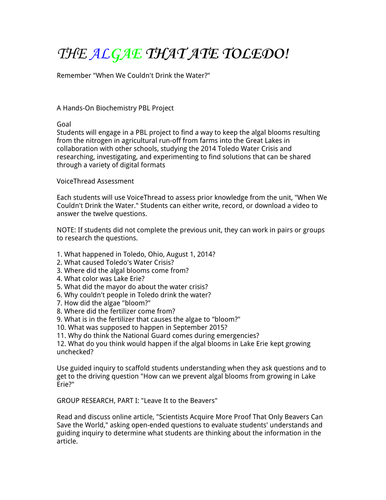
This PBL project-based unit continues where "When We Couldn't Drink the Water," a unit based on the 2014 Toledo Water Crisis, stopped. WWCDTW reflected all that happened in Ohio's fourth largest city the first weekend in August just weeks before the start of the 2014-2015 school year.
This project seeks a solution that will prevent a future water crisis like the one in Toledo. Based on scientific principles and concepts, this project involves students in collaborative research, investigation and experimentation to help them understand processes like algal blooming, denitrification, and bioreactors.
Students will be emerged in the ongoing struggle for water quality in the Great Lakes , the cycle of denitrifcation, beaver dam-building, and bioreactors designing and construction. Students with advanced scientific skills and/or gifted students will have differentiation, as well as will students with special needs.
Assessments are imbedded. There is also a pretest to assess prior knowledge.
A Hands-On Biochemistry PBL Project
Goal
Students will engage in a PBL project to find a way to keep the algal blooms resulting from the nitrogen in agricultural run-off from farms into the Great Lakes in collaboration with other schools, studying the 2014 Toledo Water Crisis and researching, investigating, and experimenting to find solutions that can be shared through a variety of digital formats.
Toledo Water Crisis http://voicethread.com/share/7306686
This project seeks a solution that will prevent a future water crisis like the one in Toledo. Based on scientific principles and concepts, this project involves students in collaborative research, investigation and experimentation to help them understand processes like algal blooming, denitrification, and bioreactors.
Students will be emerged in the ongoing struggle for water quality in the Great Lakes , the cycle of denitrifcation, beaver dam-building, and bioreactors designing and construction. Students with advanced scientific skills and/or gifted students will have differentiation, as well as will students with special needs.
Assessments are imbedded. There is also a pretest to assess prior knowledge.
A Hands-On Biochemistry PBL Project
Goal
Students will engage in a PBL project to find a way to keep the algal blooms resulting from the nitrogen in agricultural run-off from farms into the Great Lakes in collaboration with other schools, studying the 2014 Toledo Water Crisis and researching, investigating, and experimenting to find solutions that can be shared through a variety of digital formats.
Toledo Water Crisis http://voicethread.com/share/7306686
Something went wrong, please try again later.
Thank you for sharing your resource. This resource has been recommended for teachers by the TES Resource Team.
Report this resourceto let us know if it violates our terms and conditions.
Our customer service team will review your report and will be in touch.
$4.99
